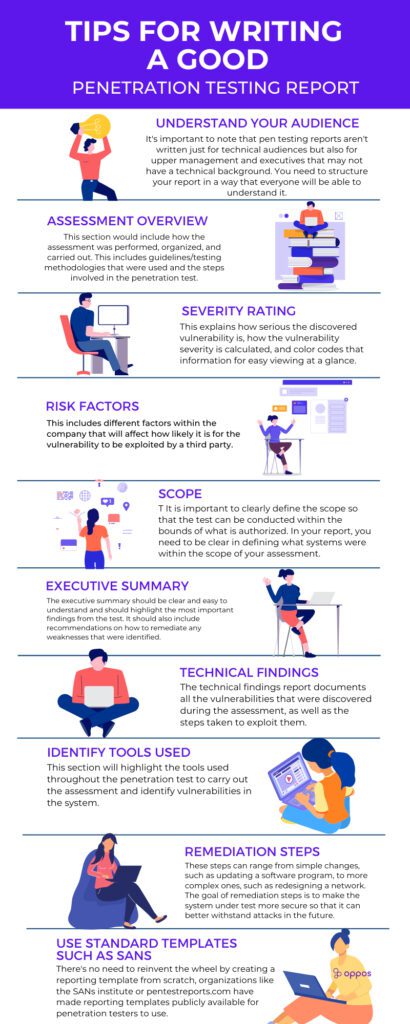When it comes to penetration testing, the most important thing is to understand the methodology and process involved. With that said, one of the key deliverables of a successful penetration test is a comprehensive and well-written report.
A penetration testing report should be clear, concise, and easy to understand. It should also be free of technical jargon. The report should be tailored to the specific needs of the client.
In this article, we will discuss how to write a good penetration testing report. We will also provide a template that can be used as a guide.

Why is writing a good penetration testing report important?
Penetration testing is a critical component of cybersecurity, but it’s not enough to just find vulnerabilities. You also need to document your findings in a clear and concise report.
A good penetration testing report does more than just document vulnerabilities. It also provides recommendations on how to fix the issues and prevent similar problems in the future. This can be immensely valuable to businesses, as it can help them avoid costly downtime and data breaches.
A well-written penetration testing report can also be used as a marketing tool. It can show potential clients that your business takes cybersecurity seriously and that you have the skills and experience to find and fix their vulnerabilities.
Overall, writing a good penetration testing report is important because it can help businesses avoid costly problems, it can be used as a marketing tool, and it can help improve the overall security of the internet.
Tips for writing a good penetration testing report
Understand your audience
It’s important to note that pen testing reports aren’t written just for technical audiences but also for upper management and executives that may not have a technical background. You need to structure your report in a way that everyone will be able to understand it.
Assessment Overview
This section would include how the assessment was performed, organized, and carried out. This includes guidelines/testing methodologies that were used and the steps involved in the penetration test.
Severity Rating
This explains how serious the discovered vulnerability is, how the vulnerability severity is calculated, and colour codes that information for easy viewing at a glance.
Risk Factors
This includes different factors within the company that will affect how likely it is for the vulnerability to be exploited by a third party.

Scope
The scope defines the boundary of the test and what systems or networks will be included. It is important to clearly define the scope so that the test can be conducted within the bounds of what is authorized. In your report, you need to be clear in defining what systems were within the scope of your assessment.
Executive Summary
An executive summary is a key component of a penetration test report. It is a concise summary of the key findings and recommendations from the test and is typically presented to senior management or the board of directors. The executive summary should be clear and easy to understand and should highlight the most important findings from the test. It should also include recommendations on how to remediate any weaknesses that were identified. If you are preparing a penetration test report, be sure to include an executive summary so that your key findings and recommendations can be easily understood by decision-makers.
Technical Findings
Technical findings in a penetration test report are defined as a finding that weakens the security posture of the system under test. The technical findings report documents all the vulnerabilities that were discovered during the assessment, as well as the steps taken to exploit them.
Identify Tools used
This section will highlight the tools used throughout the penetration test to carry out the assessment and identify vulnerabilities in the system. One reason this may be important is that clients may want to know that the techniques and tools that you are using are similar to what they can expect attackers in real life to use against their systems. This would mean that they are getting a better simulation of real-world attacks.
Remediation Steps
In a penetration test, remediation steps are taken to fix any vulnerabilities that are found. These steps can range from simple changes, such as updating a software program, to more complex ones, such as redesigning a network. The goal of remediation steps is to make the system under test more secure so that it can better withstand attacks in the future. Ultimately the goal of a penetration test is to improve the security of the company and this section is designed to tell stakeholders exactly how they can do that. It’s important to explain the steps in detail and give alternative ways to fix your vulnerabilities in case your client is unable to take a particular course of action.
Use standard templates such as SANs
Another recommendation we give is to use standard reporting templates by recognized organizations. There’s no need to reinvent the wheel by creating a reporting template from scratch, organizations like the SANs institute or pentestreports.com have made reporting templates publically available for penetration testers to use.
How to write a good report by hackersploit
In this section, we’re going to feature a video from a youtube channel called hackersploit. This youtube channel focuses on penetration testing and gives some of the best free cybersecurity content I’ve seen. In this video, he talks about how to create and write high-quality penetration testing reports and discusses all of the tips that he has accumulated over his many years as a cybersecurity professional.
Recap
In conclusion, a good penetration testing report must be well-organized, thorough, and easy to understand. It should also include a Summary section that highlights the most important findings. To get more information on writing good penetration testing reports, subscribe to our newsletter.






